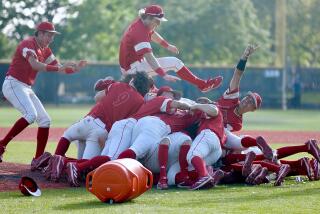MOORPARK : Methodist Church Celebrates 100 Years
In its early years, the United Methodist Church in Moorpark was the nucleus of the town.
“The church in those days was more or less the center of spiritual and social activities in the community,” said Monroe Everett, 84, who has attended the 100-year-old church since he was an infant.
“At least my folks didn’t do much except go to church and attend the programs there,” the retired apricot and citrus fruit farmer said.
The United Methodist Church is celebrating its centennial this year. As the first church built in the area, the building was used as a county medical clinic, and a meeting hall for Rotary Club and other civic groups. It even doubled as the city’s first movie hall.
Although membership has swelled from 25 to 200 members, the church can no longer claim such a pivotal role in the town that has witnessed a similar explosion in numbers. Moorpark has mushroomed in population from 7,800 in 1980 to more than 25,500 today.
Catholics, Baptists and various other Protestant denominations have thriving congregations in the city. Most area civic groups have found secular meeting halls elsewhere.
But the church remains in the city’s geographical center, the downtown neighborhood that is now populated mainly by middle- and lower-income Latinos, the Rev. Walt C. Dilg Jr. said.
About 10 years ago, the church’s predominantly Anglo congregation considered, and rejected, building a new home in one of the newer, outlying subdivisions where most members had moved.
“There were decisions made, I guess, that we would claim the identity that we’ve had, that we’d be a church of the community,” rather than become a neighborhood church for the wealthier Peach Hill or Mountain Meadows subdivisions, Dilg said.
“We’re trying to develop a Hispanic ministry,” Dilg said, “and be able to reach out to our immediate neighbors.”
Spanish-language Bible study is now getting started, Dilg said. The church’s preschool includes Latinos from the surrounding neighborhood. And the church pays the scouting fees for poorer children who join the Boy or Girl Scout troops sponsored by the church.
In addition to reaching out to the poor and minorities, the congregation’s leaders also try to bridge the gap between older and younger church members, Dilg said.
“We’ve tried to nurture a congregation here that is growing with the newer people that are coming into town, but not at the expense of the older residents,” Dilg said.
More to Read
Sign up for Essential California
The most important California stories and recommendations in your inbox every morning.
You may occasionally receive promotional content from the Los Angeles Times.










